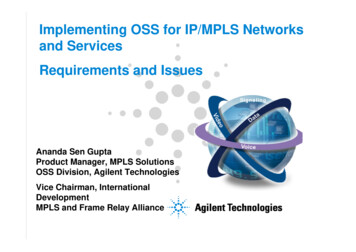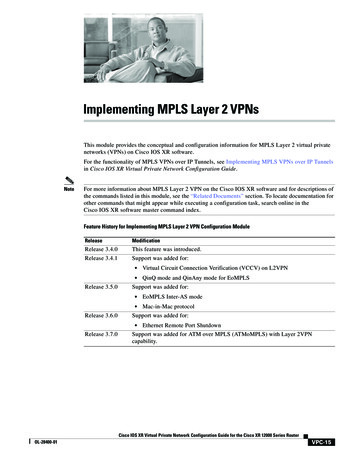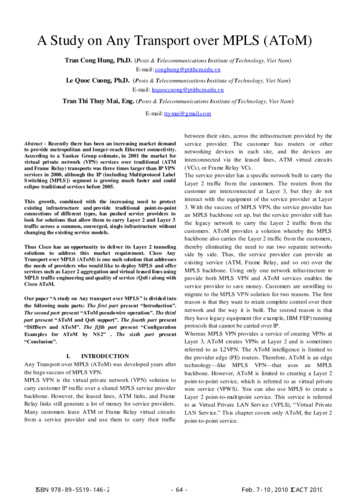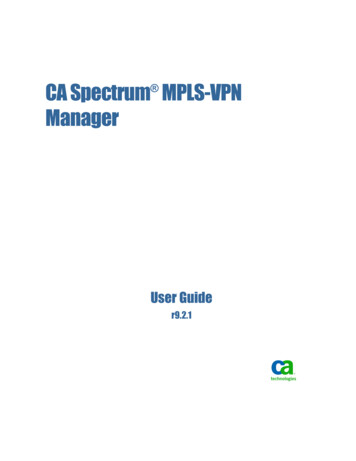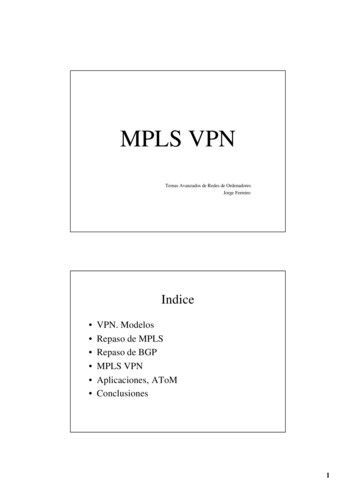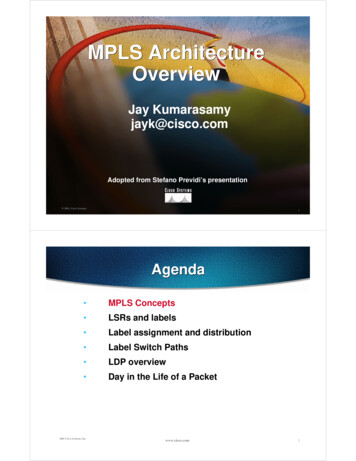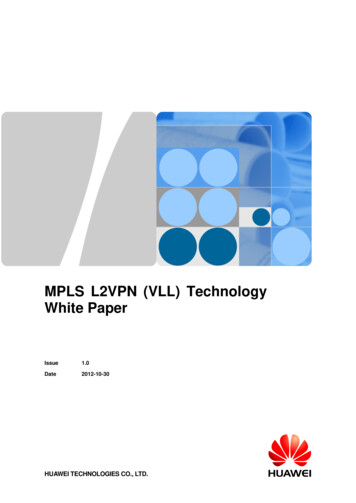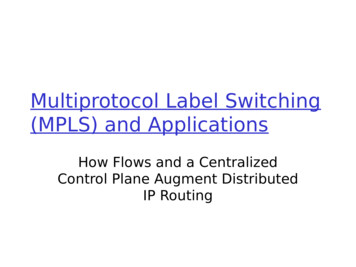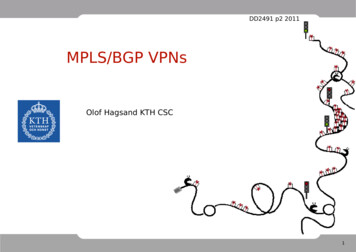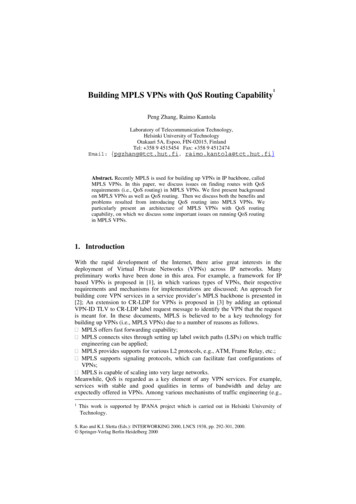
Transcription
1Building MPLS VPNs with QoS Routing CapabilityPeng Zhang, Raimo KantolaLaboratory of Telecommunication Technology,Helsinki University of TechnologyOtakaari 5A, Espoo, FIN-02015, FinlandTel: 358 9 4515454 Fax: 358 9 4512474Email: {pgzhang@tct.hut.fi, raimo.kantola@tct.hut.fi}Abstract. Recently MPLS is used for building up VPNs in IP backbone, calledMPLS VPNs. In this paper, we discuss issues on finding routes with QoSrequirements (i.e., QoS routing) in MPLS VPNs. We first present backgroundon MPLS VPNs as well as QoS routing. Then we discuss both the benefits andproblems resulted from introducing QoS routing into MPLS VPNs. Weparticularly present an architecture of MPLS VPNs with QoS routingcapability, on which we discuss some important issues on running QoS routingin MPLS VPNs.1. IntroductionWith the rapid development of the Internet, there arise great interests in thedeployment of Virtual Private Networks (VPNs) across IP networks. Manypreliminary works have been done in this area. For example, a framework for IPbased VPNs is proposed in [1], in which various types of VPNs, their respectiverequirements and mechanisms for implementations are discussed; An approach forbuilding core VPN services in a service provider’s MPLS backbone is presented in[2]; An extension to CR-LDP for VPNs is proposed in [3] by adding an optionalVPN-ID TLV to CR-LDP label request message to identify the VPN that the requestis meant for. In these documents, MPLS is believed to be a key technology forbuilding up VPNs (i.e., MPLS VPNs) due to a number of reasons as follows. MPLS offers fast forwarding capability; MPLS connects sites through setting up label switch paths (LSPs) on which trafficengineering can be applied; MPLS provides supports for various L2 protocols, e.g., ATM, Frame Relay, etc.; MPLS supports signaling protocols, which can facilitate fast configurations ofVPNs; MPLS is capable of scaling into very large networks.Meanwhile, QoS is regarded as a key element of any VPN services. For example,services with stable and good qualities in terms of bandwidth and delay areexpectedly offered in VPNs. Among various mechanisms of traffic engineering (e.g.,1This work is supported by IPANA project which is carried out in Helsinki University ofTechnology.S. Rao and K.I. Sletta (Eds.): INTERWORKING 2000, LNCS 1938, pp. 292-301, 2000. Springer-Verlag Berlin Heidelberg 2000
Building MPLS VPNs with QoS Routing Capability293traffic scheduling, resource management), QoS routing is one of the enhancingmechanisms for deploying quality classes into the IP networks[4]. The generalobjective of QoS routing is to improve the efficient utilization of network resourcesand to provide flexibility in support for various services. Therefore, QoS routing isexpectedly used in MPLS VPNs. However, there still lacks insensitive study on thistopic.In this paper, we investigate the issues of QoS routing in MPLS VPNs. Inparticular, we present an architecture of MPLS VPNs with QoS routing capability aswell as some methods for operating QoS routing in MPLS VPNs.The remainder of this paper is organized as follows. In section 2, we describe thebackground on MPLS VPNs and QoS routing. In section 3, we discuss the benefitsand problems resulted from introducing QoS routing into MPLS VPNs. We presentand describe an architecture of MPLS VPNs with QoS routing capability in section 4.In section 5, we present and discuss some issues on operating QoS routing in MPLSVPNs. Some conclusions are given in the final section.2. Background on MPLS VPNs and QoS RoutingIn this section, we give the general information on MPLS VPNs and QoS routing. Wedescribe the definitions and current status of some components as follows.2.1VPNsA VPN is a set of sites which are attached to a common network (i.e., backbone),applying a set of specific policies (e.g., addressing, security, etc). VPN services arewidely used for interconnecting sub-divisions of an organization or a company inmultiple areas. VPNs are meant for sharing resources within VPNs.Although VPN services have appeared for a few years, constructing VPNs acrossIP backbone is a relatively new topic [1]. There are two different methods to constructVPNs across IP backbone, i.e., CPE (Custom Premises Equipment) based andnetwork based. Most current VPN implementations are based on CPE equipment.VPN capabilities are being integrated into a wide variety of CPE devices, rangingfrom firewalls to WAN edge routers. On the other hand, there is also significantinterest in ‘network based VPNs’, where the operation of the VPN is outsourced to anInternet Service Provider (ISP), and is implemented on network as opposed to CPEequipment. This method attracts both customers seeking to reduce support costs andISPs seeking new revenue sources. In this paper, we discuss QoS routing in networkbased VPNs. However, most of the methods presented in this paper can also apply toCPE based VPNs.
2942.2Peng Zhang and Raimo KantolaMPLSMPLS integrates a label swapping framework with network layer routing [5]. Its basicidea involves assigning short fixed length labels to packets at the ingress to an MPLScloud (based on the concept of forwarding equivalence classes) and makingforwarding decisions accroding to the labels attached to packets throughout theinterior of the MPLS domain. Thousands of papers on MPLS have been presented invarious aspects including traffic engineering and implementations. MPLS is regardedas a key technology for realizing Differentiated Services (DiffServ) networks.2.3MPLS VPNsVPNs are built up by using MPLS. A MPLS VPN can consists of that are from thesame enterprise or from different enterprises and these sites may attach to the sameservice provider or to different service provider. If more than one different serviceproviders are used, the bilateral or multilateral agreements should be pre-determined.Moreover, MPLS based VPNs provide the following benefits [6]. A platform for rapid deployment of additional value-added IP services, includingintranets, extranets, voice, multimedia, and network commerce; Privacy and security are equal to layer-2 VPNs by constraining the distribution of aVPN’s routes to only those routers that are members of that VPN, and by usingMPLS for forwarding; Easy management of VPN membership and rapid deployment of new VPNs; Increased scalability with thousands of sits per VPN and hundreds of VPNs perservice provider; Scalable any-to-any connectivity for extended intranets and extranets thatencompass multiple businesses.2.4QoSThe QoS requirements for a service are generally clarified by a set of parameters suchas bandwidth, delay and so on. Offering QoS guaranteed or assured services in theInternet is becoming more and more attractive. Great efforts have been devoted to thisfield in various aspects, e.g., traffic scheduling, resource management, QoS routing,etc[7].2.5QoS RoutingConstraint based routing, a general term of QoS routing, selects routes according tonot just a single metric (e.g., hop count) but also additional routing metrics (e.g.,bandwidth and delay) and administrative policies (e.g., access authentication). Inparticular, QoS routing provides support for alternate routing, for instance, if the bestexisting path cannot admit a new flow, the associated traffic can be forwarded in anadequate alternate path. QoS routing algorithms can prevent traffic shifting from one
Building MPLS VPNs with QoS Routing Capability295path to another "better" path only if the current path meets the service requirements ofthe existing traffic. A framework for QoS routing in the Internet is presented in [8].QoS routing has been introduced into OSPF as described in [9]. A large number ofrouting algorithms are summarized in [4]. Some mechanisms for operating interdomain QoS routing in DiffServ networks are presented in [10].2.6QoS Routing in MPLS VPNsMPLS supports explicit paths and alternative paths so that QoS routing can benaturally used in MPLS VPNs. QoS routing might be used in such cases as findingroutes for connecting a number of sites into a VPN or setting up paths for sessionswithin VPNs. QoS routing is also believed to be one of the key components forsupporting QoS in MPLS VPNs.3. Benefits and Problems of QoS Routing in MPLS VPNsQoS routing determines routes under the knowledge of network resource availability,as well as the requirements of flows. As a result, the performance of applications isguaranteed or improved in comparison with that without QoS routing. Meanwhile,QoS routing optimizes the resource usage in the network by improving the totalnetwork throughput. QoS routing is likely used for constructing an efficient and highperformance MPLS VPNs. These benefits might be achieved in a number of ways asfollows. QoS routing selects feasible routes by avoiding congested nodes or links; If workload exceeds the limit of existing paths, QoS routing offers multiple pathsfor transferring additional traffic; If a link or node failure occurs, QoS routing selects alternative paths for quickrecovery without seriously degrading the quality.However, these benefits of QoS routing also incur the cost of developing new routingprotocols or extending the existing ones. Moreover, it potentially increases highercommunication, processing and storage overheads. It brings out a number of problemsas follows[8]: What kinds of resource information can be used for determining feasible routes? Which protocols are suitable for distributing route and resource information withindomain or across multiple domains? How to select routes across multiple domains? How to balance the complexities and benefits of introducing QoS routing into thereal networks? In which ways the cost of running QoS routing in MPLS VPN networks can beminimized?Currently, there lacks deep and broad investigations on these problems although somework have already been carried on[9].
296Peng Zhang and Raimo Kantola4. An Architecture for QoS Routing in MPLS VPNs4.1ArchitectureWe present the architecture as shown in Figure 1. A MPLS VPN is built up byconnecting MPLS sites through tunnels across IP backbone. Each MPLS site has aBandwidth Broker (BB), which is to exchange route and signaling information and tomanage and maintain VPN networks.A Central Bandwidth Broker (CBB) in IP backbone is likely used, however, notnecessarily. If the IP backbone can provide QoS support, CBB performs similarfunctions as BBs in each MPLS site. BBs of each MPLS site can negotiate with theCBB in order to setup QoS guaranteed tunnels or sessions. CBB performs VPNmanagement in a central way, for example, CBB determines the acceptance of aMPLS site into the MPLS VPN. CBB can be implemented in any router in IPbackbone, or virtually in BB of a MPLS site.Both BB and CBB have two major tasks related to route management: Finding routes for connecting a number of sites into a VPN; Setting up paths for sessions within VPNs.The first task has a longer time scale than the second task. In this paper, we intend tofocus on the second task.Fig. 1. An Architecture of MPLS VPNs with QoS RoutingEach bandwidth broker consists of a number of components, i.e., VPNManagement, Signaling Protocol, QoS Routing and Traffic Engineering. VPNManagement performs functions of management and administrative policies, e.g.,addressing, access authentication, tunneling management, etc. Signaling Protocol isneeded to setup tunnels between MPLS sites or sessions between applications ofdifferent MPLS sites. QoS routing is used for finding feasible routes for tunnels orsessions and for maintaining topology of MPLS VPNs. Traffic Engineering includes a
Building MPLS VPNs with QoS Routing Capability297number of mechanisms (e.g., classifying, marking, shaping and queuing) forforwarding packets.In practice, there are several candidates for implementing these components. ForVPN Management, SNMP might be used; For Signaling Protocol, CR-LDP orExtended RSVP can be used; For QoS Routing, QOSPF or inter-domain QoS routingmight be used; For traffic engineering, Integrated Service or Differentiated Servicemight be used.The functions of these components can be understood by depicting the process ofsetting up a path for a flow with quantitative QoS requirements.1. When a BB (or CBB) receives a request for a flow, it determines a set of possibleroutes and then selects a feasible route;2. Once a path has been found, the BB (or CBB) assures that the flow follows thepath;3. The BB updates its local resource database and broadcasts the route and resourceinformation to other nodes;4. The BB marks the flow packets and polices the flow;5. The BB monitors the link state to detect a link failure and performs rerouting incase link failure occurs.4.2QoS Routing ModelSince this paper focuses on QoS routing, we present an implementation of QoSrouting component in Figure 2.As shown in this figure, this model consists of three functional blocks (i.e., PolicyControl, Route Computation & Selection, and Routing Information Advertise andUpdate) and three tables (i.e., VPN topology database, tunnels & sessions table, andtunnels & sessions routing table).Policy Control exerts specified policies on finding routes and exchanging routinginformation. Route Computation & Selection determines routes based on theknowledge of topology information and policy constraints.Routes are computed and saved into tunnels & sessions table for data forwarding.The tunnels & sessions table is used to store information related to specific flows, interms of traffic parameters, requirements for QoS, etc. Routing InformationFig. 2. An Implementation of QoS Routing
298Peng Zhang and Raimo KantolaAdvertisement and Update is in charge of broadcasting routing information (e.g.,resource information, policy constraints, routes selected, etc) and updating localdatabase when receiving VPN routing information from other sites.Here, we introduce two simple routing algorithms: Lowest Cost (LC) algorithmand Widest Bandwidth (WB) algorithm[11].Consider a directed graph G (N, E) with numbers of nodes N and numbers ofedges E, in which each edge (i, j) is weighted by two parameters, bij as the availablebandwidth and cij as the cost. The cost is an additive parameter, e.g., hop number,delay, etc. Let bij 0 and cij if edge (i, j) does not exist in the graph.Given any directed path p (i,j,k, , l, m), define b(p) as the bottleneck bandwidthof the path, i.e., b(p) min[bij , bjk, , blm], and define c(p) as the sum of the cost, i.e.,c(p) cij cjk clm. Given two nodes i and m of the graph and two constraints Band C. To LC algorithm, the QoS routing problem is to find a path p* between i andm so that b(p) B and c(p) C. To WB algorithm, the QoS routing problem is then tofind a path p* between i and m so that b(p) B and the path has the widest bandwidth,and if there are more than one widest paths the path with the lowest cost is selected.Let Ci be the estimated cost of the path from source node s to destination node t. LetBi be the estimated bandwidth of the path from source node s to destination node t. LC algorithmStep 1: Set cij , if bij B;Step 2: Set L {s}, Ci csi for all i s;Step 3: Find k L so that Ck mini L Ci;If Ck C, no such a path can be found and the algorithm terminates,If L contains node t, a path is found and the algorithm terminates.L: L {k}.Step 4: For all i L, set Ci: min[Ci, Ck cki];Step 5: Go to Step 3. WB algorithm:Step 1: Set bij 0, if bij B;Step 2: Set L {s}, Bi bsi and Ci csi for all i s;Step 3: Find set K L so that BK maxi L Bi;Step 4: If K has more than one element, find k K so that Ci (s, , k, t) mini K [C(s, , k, t)]. L: L {k}. If L contains all nodes, the algorithm is completed.Step 5: For all i L, set Bi: max[Bi, min[Bk, bki]];Step 6: Go to Step 3.Both algorithms first eliminate the link whose available bandwidth is below therequired bandwidth and produces a new graph. Then, the former calculates path withthe lowest cost by using Dijkstra’s algorithm while the latter calculates the path withthe widest bandwidth by using a variation of Dijkstra’s algorithm.The other important topic of QoS routing is cost. The cost of QoS routing includesthree parts, that is, storage cost, computation cost and distribution cost. Usually, itmainly depends on the distribution cost. Therefore, the updating algorithm of routeand resource information is very important. Here, we briefly present two updatingalgorithms as follows. The first algorithm, called Period Based algorithm (PB), performs updateperiodically.
Building MPLS VPNs with QoS Routing Capability299 The second algorithm, called Threshold Based algorithm (TB), performs updatewhen the variation of available bandwidth of the link exceeds a configuredthreshold.5. Issues on Running QoS Routing in MPLS VPNsIn this section, we present and discuss some issues on running QoS routing in MPLSVPNs in the following subtopics. Distributing label and VPN attributesIn MPLS VPNs, labels and VPNs attributes (e.g., label ID, VPN ID, etc) can bedistributed and maintained by using QoS routing protocols. Extensions to BGP forcarrying label and VPN attributes in MPLS VPN are proposed in [2, 12]. One canconstruct different kinds of VPNs, by setting up the Target and Origin VPN attributes.For example, label distribution can be piggybacked in the BGP Update message byusing the BGP-4 Multiprotocol Extensions attribute[13]. The label is encoded into theNLRI field of the attribute. Label mapping information is carried as part of theNetwork Layer Reachability Information (NLRI) in the Multiprotocol Extensionsattributes.Fig. 3. Format of NLRI for label distribution in BGP-4The Network Layer Reachability information is encoded as one or more triples ofthe form label, length, prefix as shown in Figure 3. The Length field indicates thelength in bits of the address prefix plus the label(s); The Label field carries one ormore labels; The Prefix field contains address prefixes followed by enough trailingbits to make the end of the field fall on an octet boundary.The other alternative uses signaling protocol for distributing label and VPNattributes. Distributing route and topology informationQoS routing can be used for maintaining VPN topology within VPN. It is used forunderstanding not only the topology information but also resource states in VPNs, inwhich deliberate control and management can be applied. The resource states can beclarified with a number of parameters, e.g., bandwidth, delay, etc.For example, BGP-4 can be extended for supporting traffic engineering[14]. TheBGP update message will contain a new Optional Transitive attribute called TEWeight. The traffic engineering weights act as a cost or distance function, describingthe quality of a path to a destination network in traffic engineering terms. Each TEWeight type could be: Maximum Bandwidth Available Maximum Number of IGP Hops
300Peng Zhang and Raimo Kantola Maximum Transit Delay Color Etc.Therefore, the routes with quality information are distributed, then BGP RouteSelection process is extended to select routes on the basis of the TE weights. Finding feasible routesThere are a number of algorithms for finding QoS routes in a single domain[4]. Thetwo routing algorithms presented in section 4.2 are very promising and expectedlyused in the real network because of their simplicities. On the other hand, bothalgorithm use bandwidth as the key parameter because in many cases bandwidthdominates the quality of service.Moreover, some mechanisms for operating inter-domain QoS routing are proposedin [10]. In this case, Figure 4 illustrates the main functions and the procedures forsetting up paths across domains. Signaling entity (SE) is a signaling agent of a MPLSsite, while routing entity (RE) is a routing agent of a MPLS site running inter-domainQoS routing protocols. SE’s functions include outgoing and incoming parts. Theoutgoing part collects QoS requests from interior routers and determine to initiatepath setup requests; The incoming part processes path setup requests from other SEs.SE queries its local RE for external routes, and RE replies SE with next hops or wholeroutes. Note that the path setup request message usually contains the specifications ofthe flow and the requirements for QoS.Fig. 4. Setting up paths across domainWe present five mechanisms for operating QoS routing across domains [10]:1. SE based - crankback2. SE based – flooding3. Cache based Routing4. D-hop resource routing5. RE based source routingFor brevity, we just describe the first mechanism as follows.When SE receives a path setup request message from an upstream SE, it firstrequests its local RE for next hop. If RE replies a non-blank next hop, SE checks ifthere is enough available resource on the link to that hop. If yes, SE adds itself toroute list of the path and sends a request to that hop. If no, it requests the local RE fornext hop again. If SE has queried RE for K times, SE sends a path setup failuremessage upstream. Here, K is a given constant. If SE receives a path setup failuremessage from downstream SE, it also requests its local RE for next hop again. A
Building MPLS VPNs with QoS Routing Capability301feasible route will be found until the request reaches the destination. In this case,resource reservation is proceeded downstream.This mechanism does not require RE to understand the global resourceinformation, that is, there is no need for global topology and resource informationdatabase. As a result, advertising and updating resource information can be avoided.The current inter-domain routing protocol (i.e., BGP) can be directly used, exceptminor modifications on interface with SE.6. ConclusionsMPLS is likely used in VPNs due to its distinguished merits, e.g., fast forwarding,tunneling, etc. QoS routing is naturally used in MPLS VPNs for providing feasibleroutes with considerations on QoS constraints. QoS routing is beneficial fordeveloping QoS guaranteed MPLS VPNs across IP networks. In this paper, weinvestigate both benefits and problems when introducing QoS routing into MPLSVPNs. Particularly, we present an architecture of MPLS VPNs with QoS routingcapability and discuss some issues on running QoS routing in MPLS VPNs. However,there are still a great number of open research problems concerning QoS routing inMPLS VPNs, e.g., methods of advertising and updating resource information,algorithms of computing routes, etc.References1. B. Gleeson, et al: A Framework for IP Based Virtual Private Networks. IETF RFC2764(2000)2. K. Muthukrishnan, et al: Core MPLS IP VPN Architecture. IETF Draft (2000)3. P. Houlik, et al: Extensions to CR-LDP for VPNs. IETF Draft (2000)4. Chen, S., Nahrstedt, K.: An Overview of Quality of Service Routing for Next-GenerationHigh-Speed Networks: Problems and Solutions. IEEE Networks, Vol. 12, No. 6 (1998) 64795. R. Callon, et al: A Framework for MPLS. IETF Draft (1999)6. Cisco VPN Solution Center: MPLS Solution User Guide. Chapter 1 (1999) page 3-47. S. Blake, et al: An Architecture for Differentiated Services. IETF RFC2475 (1998)8. E. Crawley, et al: A Framework for QoS-based Routing in the Internet. IETF RFC2386(1998)9. G. Apostolopoulos, et al: QoS Routing Mechanisms and OSPF Extensions. IETF RFC2676(1999)10. P. Zhang, R. Kantola: Mechanisms for Inter-Domain QoS Routing in Differentiated ServiceNetworks. Accepted by QoS of future Internet Services (QofIS’2000). Berlin (2000)11. Z. Wang and J. Crowcroft: Quality of Service Routing for Supporting MultimediaApplications. IEEE JSAC, Vol.14, No.7 (1996) 1228-123412. P. Houlik, et al: Carrying Label Information in BGP-4. IETF Draft (2000)13. T. Bates, et al: Multiple Extensions for BGP-4. IETF RFC2283. (1998)14. B. Abarbanel, S. Venkatachalam: BGP-4 Support for Traffic Engineering. IETF Draft(2000)
building core VPN services in a service provider's MPLS backbone is presented in [2]; An extension to CR-LDP for VPNs is proposed in [3] by adding an optional VPN-ID TLV to CR-LDP label request message to identify the VPN that the request is meant for. In these documents, MPLS is believed to be a key technology for
